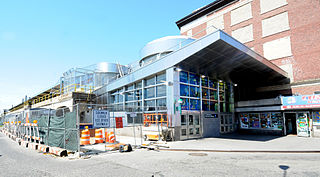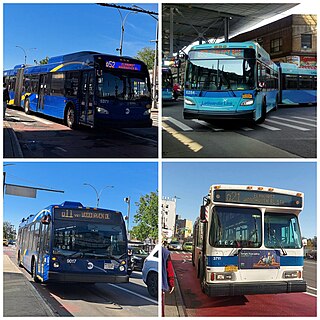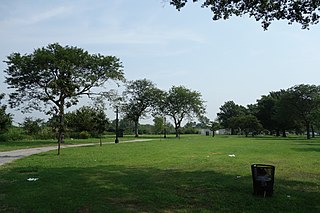Related Research Articles

The A Eighth Avenue Express is a rapid transit service in the B Division of the New York City Subway. Its route emblem, or "bullet", is colored blue since it is a part of the IND Eighth Avenue Line in Manhattan.

The Rockaway Peninsula, commonly referred to as The Rockaways or Rockaway, is a peninsula at the southern edge of the New York City borough of Queens on Long Island, New York. Relatively isolated from Manhattan and other more urban parts of the city, Rockaway became a popular summer retreat in the 1830s. It has since become a mixture of lower, middle, and upper-class neighborhoods. In the 2010s, it became one of the city's most quickly gentrifying areas.

Far Rockaway is a neighborhood on the eastern part of the Rockaway peninsula in the New York City borough of Queens. It is the easternmost section of the Rockaways. The neighborhood extends from Beach 32nd Street east to the Nassau County line. Its southern boundary is the Atlantic Ocean; it is one of the neighborhoods along Rockaway Beach.

Rockaway Beach is a neighborhood on the Rockaway Peninsula in the New York City borough of Queens. The neighborhood is bounded by Arverne to the east and Rockaway Park to the west. It is named for the Rockaway Beach and Boardwalk, which is the largest urban beach in the United States, stretching from Beach 3rd to Beach 153rd Streets on the Atlantic Ocean. The neighborhood, with 13,000 residents as of 2010, is also known as the "Irish Riviera" because of its large Irish American population.

The Howard Beach–JFK Airport station is a subway/people mover station complex located at Coleman Square between 159th Avenue and 103rd Street in Howard Beach, Queens. The New York City Subway portion of the station is on the IND Rockaway Line and is served by the Rockaway branch of the A train at all times, and the AirTrain JFK portion of the station complex is served by the AirTrain's Howard Beach branch at all times.

The Atlantic Terminal is the westernmost commuter rail terminal on the Long Island Rail Road's (LIRR) Atlantic Branch, located at Flatbush Avenue and Atlantic Avenue in Downtown Brooklyn, New York City. It is the primary terminal for the West Hempstead Branch, and a peak-hour terminal for some trains on the Hempstead Branch, Far Rockaway Branch, and the Babylon Branch; most other service is provided by frequent shuttles to Jamaica station. The terminal is located in the City Terminal Zone, the LIRR's Zone 1, and thus part of the CityTicket program.

The Broad Channel station is a station on the IND Rockaway Line of the New York City Subway, located in the neighborhood of the same name at Noel and West Roads in the borough of Queens. It is served by the A train and the Rockaway Park Shuttle at all times, the latter of which originates/terminates here. Broad Channel originally opened in 1880 as a Long Island Railroad station. The LIRR discontinued service in 1950 after a fire on the trestle across Jamaica Bay, to the station's north. The station reopened June 28, 1956, as a subway station.

The Far Rockaway Branch is an electrified rail line and service owned and operated by the Long Island Rail Road in the U.S. state of New York. The branch begins at Valley Interlocking, just east of Valley Stream station. From Valley Stream, the line heads south and southwest through southwestern Nassau County, ending at Far Rockaway in Queens, thus reentering New York City. LIRR maps and schedules indicate that the Far Rockaway Branch service continues west along the Atlantic Branch to Jamaica. This two-track branch provides all day service in both directions to Grand Central Madison and Penn Station, both in Midtown Manhattan.

Hog Island was the name of two islands near Long Island, New York until the 1890s. One is the present day Barnum Island, which includes the villages of Island Park and Harbor Isle in Nassau County. The other was a mile-long (1600 m) barrier island that existed to the south of Rockaway Beach in Queens before being mostly destroyed by the 1893 New York hurricane and completely lost to erosion and storm damage by 1902.

The Rockaway Park–Beach 116th Street station is the western terminal station on the IND Rockaway Line of the New York City Subway, located on Beach 116th Street near Rockaway Beach Boulevard in Rockaway Beach, Queens. It is served by the Rockaway Park Shuttle at all times and ten daily rush-hour A trains in the peak direction.

The Far Rockaway–Mott Avenue station is the eastern terminal station of the New York City Subway's IND Rockaway Line. Originally a Long Island Rail Road station, it is currently the easternmost station in the New York City Subway. It is served by the A train at all times.
The IND Rockaway Line is a rapid transit line of the IND Division of the New York City Subway, operating in Queens. It branches from the IND Fulton Street Line at Rockaway Boulevard, extending over the Jamaica Bay, into the Rockaways. At its southern end in the Rockaways, the line has two branches: one traveling east to Far Rockaway–Mott Avenue and one traveling west to Rockaway Park–Beach 116th Street. The A train serves the line on the Far Rockaway branch, as well as on the section north of Hammels Wye. The Rockaway Park Shuttle runs between Broad Channel and Rockaway Park. Five rush hour A trains provide service between Rockaway Park and Manhattan in the peak direction.

Jacob Riis Park, also called Jacob A. Riis Park and Riis Park, is a seaside park on the southwestern portion of the Rockaway Peninsula in the New York City borough of Queens. It lies at the foot of the Marine Parkway–Gil Hodges Memorial Bridge, east of Fort Tilden, and west of Neponsit and Rockaway Beach. Originally run by the New York City Department of Parks and Recreation, it later became part of the Jamaica Bay Unit of the Gateway National Recreation Area, and is managed by the National Park Service (NPS). It features an extensive sand beach along the Atlantic Ocean coastline and several historic Art Deco structures.

Green Bus Lines, also referred to simply as Green Lines, was a private bus company in New York City, United States. It operated local service in Queens and express service to Manhattan until January 9, 2006, when the city-operated MTA Bus Company took over its routes. It was managed most recently by Jerome Cooper (1928–2015).

The Q35 bus route constitutes a public transit line in southeast Brooklyn as well as the Rockaway Peninsula of southern Queens in New York City. The Q35 is operated by MTA Regional Bus Operations under the MTA Bus Company brand, but was formerly privately operated by Green Bus Lines. The bus provides service between Midwood in central Brooklyn to Rockaway Park on the Rockaway Peninsula, running mainly along Flatbush Avenue in Brooklyn and Newport Avenue on the Rockaway Peninsula. The route utilizes the Marine Parkway–Gil Hodges Memorial Bridge to cross between Brooklyn and Queens.

The Long Beach station is an intermodal center and the terminus of the Long Beach Branch of the Long Island Rail Road. It is located at Park Place and Park Avenue in the City of Long Beach, New York, serving as the city's major transportation hub.

The Q111, Q113, and Q114 bus routes constitute a public transit line between the Jamaica and Far Rockaway neighborhoods of Queens, New York City, running primarily along Guy R. Brewer Boulevard. The Q113 and Q114 provide limited-stop service between Jamaica and Far Rockaway, connecting two major bus-subway hubs, and crossing into Nassau County. The Q111 provides local service exclusively within Queens, with the exception of select rush-hour trips to or from Cedarhurst in Nassau County. Some of the last bus routes to be privately operated in the city, they are currently operated by the MTA Bus Company brand of MTA Regional Bus Operations. The Q113 and Q114 are one of the few public transit options between the Rockaway peninsula and "mainland" New York City.

The Q11, Q21, Q52, and Q53 bus routes constitute a public transit corridor running along Woodhaven and Cross Bay Boulevards in Queens, New York City. The corridor extends primarily along the length of the two boulevards through "mainland" Queens, a distance of 6 miles (9.7 km) between Elmhurst and the Jamaica Bay shore in Howard Beach. The Q52 and Q53 buses, which provide Select Bus Service along the corridor, continue south across Jamaica Bay to the Rockaway peninsula, one of the few public transit options between the peninsula and the rest of the city.

Edgemere Landfill is a former municipal landfill located in Edgemere on the Rockaway peninsula in Queens, New York City. It is located on a man-made peninsula on the Jamaica Bay shoreline, at the eastern end of the Rockaway peninsula. A portion of the site is open to the public as Rockaway Community Park. The entire site is owned by the New York City Department of Parks and Recreation.

The Rockaway Beach and Boardwalk is a public park in Rockaway, Queens, New York, composed of the 170-acre (69 ha) Rockaway Beach and the adjacent 5.5-mile (8.9 km) Rockaway Boardwalk. The beach runs from Beach 9th Street in Far Rockaway to Beach 149th Street in Neponsit, a distance of 7 miles (11 km). The boardwalk, a concrete deck, runs from Beach 9th Street to Beach 126th Street in Rockaway Park, at the edge of Belle Harbor. There are also numerous recreational facilities within the park, parallel to the beach and boardwalk.
References
- ↑ "The Rockaways". Rootsweb.com. Retrieved March 5, 2016.
- ↑ "Hitch a Ride to Rockaway Beach". Archived from the original on October 17, 2006. Retrieved December 20, 2006.
- ↑ "Bungalows". Farrockaway.com. September 2, 2001. Retrieved March 5, 2016.
- ↑ "Community and library history". Archived from the original on September 27, 2007. Retrieved December 20, 2006.